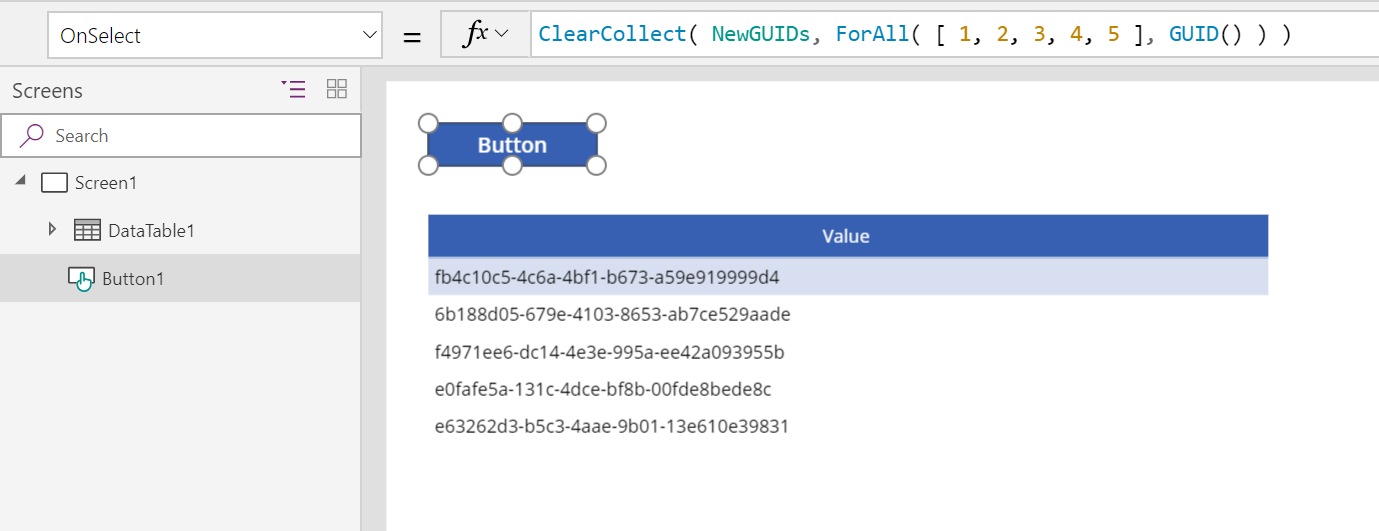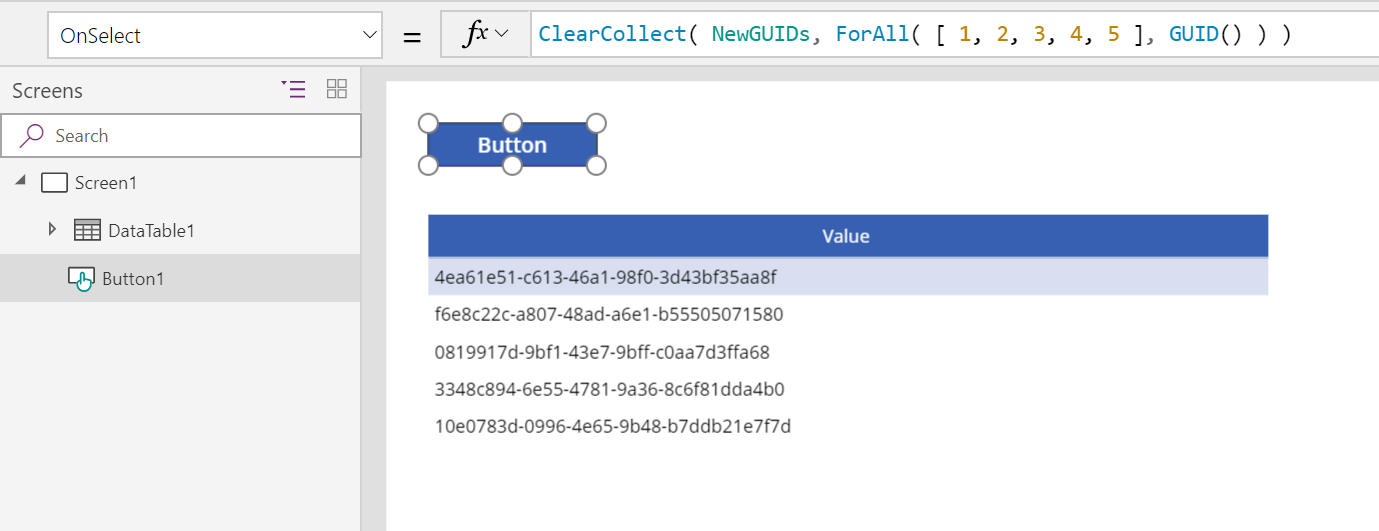Annot Create Property guid on String again
This browser is no longer supported.
Upgrade to Microsoft Border to accept advantage of the latest features, security updates, and technical support.
GUID function in Ability Apps
Converts a GUID (Globally Unique Identifier) cord to a GUID value or creates a new GUID value.
Clarification
Use the GUID role to convert a string that contains the hexadecimal representation of a GUID into a GUID value that tin can be passed to a database. GUID values are used equally keys past database systems such equally Microsoft Dataverse and SQL Server.
The cord passed tin can incorporate uppercase or lowercase letters, only it must be 32 hexadecimal digits in either of these formats:
- "123e4567-e89b-12d3-a456-426655440000" (hyphens in standard locations)
- "123e4567e89b12d3a456426655440000" (no hyphens)
If you don't specify an argument, this function creates a new GUID.
To convert a GUID value to a string, but utilize information technology in a string context. The GUID value will exist converted to a hexadecimal representation cord with hyphens and lowercase letters.
When generating a new GUID, this function uses pseudo-random numbers to create a version 4 IETF RFC 4122 GUID. When converting a string to a GUID, this function supports any GUID version by accepting any string of 32 hexadecimal digits.
Volatile functions
GUID is a volatile function when used without an argument. Each time the function is evaluated, information technology returns a unlike value.
When used in a data-flow formula, a volatile function volition return a different value only if the formula in which it appears is reevaluated. If goose egg else changes in the formula, it will have the same value throughout the execution of your app.
For instance, a label control for which the Text property is set to GUID() won't change while your app is active. Only endmost and reopening the app will result in a different value.
The function volition be reevaluated if it's office of a formula in which something else has changed. If we set the Text belongings of a Label control to this formula, for example, a GUID is generated each time the user changes the value of the Text input control:
TextInput1.Text & " " & GUID()
When used in a behavior formula, GUID will be evaluated each fourth dimension the formula is evaluated. For more information, run into the examples later in this topic.
Syntax
GUID( [ GUIDString ] )
- GUIDString – Optional. A text string that contains the hexadecimal representation of a GUID. If no string is supplied, a new GUID is created.
Examples
Bones usage
To render a GUID value based on the hexadecimal string representation:
GUID( "0f8fad5b-d9cb-469f-a165-70867728950e" ) You can also provide the GUID string without hyphens. This formula returns the aforementioned GUID value:
GUID( "0f8fad5bd9cb469fa16570867728950e" ) Used in context, to set the Status field of a new database record to a well-established value:
Patch( Products, Default( Products ), { Status: GUID( "F9168C5E-CEB2-4faa-B6BF-329BF39FA1E4" ) } ) You probably don't want to show GUIDs to your users, but GUIDs tin assist you lot debug your app. To prove the value of the Condition field in the record that yous created in the previous instance, ready the Text property of a Label control to this formula:
Get-go( Products ).Status The Label control volition bear witness f9168c5e-ceb2-4faa-b6bf-329bf39fa1e4.
Create a tabular array of GUIDs
-
Set the OnSelect property of a Push button control to this formula:
ClearCollect( NewGUIDs, ForAll( Sequence(5), GUID() ) )This formula creates a single-column tabular array that's used to iterate five times, resulting in five GUIDs.
-
Add a Data tabular array control, set up its Items property to NewGUIDs, and evidence the Value field.
-
While holding down the Alt key, select the push button by clicking or tapping information technology.
The data table shows a list of GUIDs:

-
Select the button again to bear witness a different list of GUIDs:

To generate a unmarried GUID instead of a table, use this formula:
Set( NewGUID, GUID() ) Feedback
Submit and view feedback for
Source: https://docs.microsoft.com/en-us/power-apps/maker/canvas-apps/functions/function-guid
Post a Comment for "Annot Create Property guid on String again"